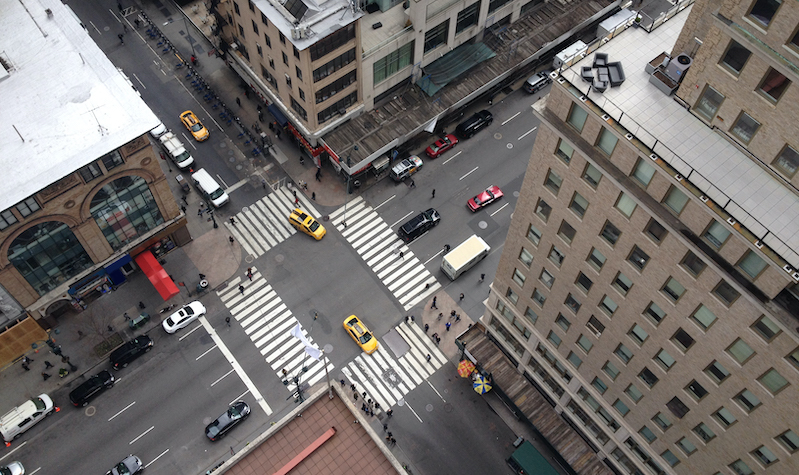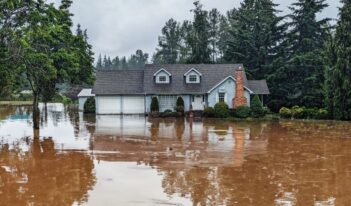
Two of the United States’ biggest challenges converge on urban heat islands.
As the world gets warmer, extreme weather events are increasingly common and increasingly devastating.
In the United States, heat waves have emerged as the leading cause of weather-related fatalities, and communities of color often face the greatest risks. The Centers for Disease Control and Prevention estimates that extreme heat kills over 600 Americans each year, which amounts to more fatalities than deaths caused by hurricanes, tornadoes, and floods combined.
Temperatures are rising all over the country, but cities have felt the brunt of the change because metropolitan areas are generally hotter than their natural surroundings. Hallmarks of urban development account for the difference: Asphalt and tall buildings trap heat.
Researchers have known about these “urban heat islands” since the 19th century but have only recently recognized a correlation between the hottest neighborhoods and a racist mortgage-lending practice known as redlining.
Redlining began in 1933, when the federal government created the Home Owners’ Loan Corporation (HOLC) to stabilize and encourage homeownership as the nation recovered from the Great Depression. HOLC provided loans to banks and homeowners who were unable to pay their mortgages. HOLC also evaluated and assigned grades to neighborhoods based on the perceived risks to lenders.
HOLC’s grading system included four designations: “best,” “still desirable,” “declining,” or “hazardous.” Neighborhoods with Black or immigrant populations were considered to be risky for investors and were often labeled “hazardous.” In some cases, a single Black family was enough for HOLC to assign the lowest rating. When HOLC created maps to illustrate these designations, it outlined the “riskiest” areas in red.
Due to these perceived risks, residents of redlined neighborhoods could not secure mortgages from HOLC or the Federal Housing Administration (FHA). Between the 1930s and 1960s, when redlining became illegal, only about 2 percent of FHA loans were given to people of color. For many people, homeownership builds wealth that they can pass down to the next generation. In fact, some economists argue that inheritance and other intergenerational transfers “account for more of the racial wealth gap than any other demographic and socioeconomic indicators.” Unsurprisingly, by the time the Fair Housing Act banned redlining in 1968, the damage was deeply entrenched. Today, 74 percent of redlined neighborhoods are deemed to be “low-to-moderate income” and many remain “hyper-segregated.”
Another result of decades of disinvestment in redlined neighborhoods is unequal urban heat distribution. In many cities, green space is concentrated in affluent and predominantly white communities. Unlike more affluent white homeowners, minority and low-income renters did not have the power to lobby city officials or landlords for more green space. Over time, property values dropped and have remained low. Urban planners have even used the cheap land for constructing highways and large building complexes out of heat-absorbing materials, such as asphalt and concrete.
As a result, historically redlined neighborhoods experience temperatures today that are hotter than the city average. In the summer, intracity temperatures can vary by more than 10 degrees Fahrenheit. Even more modest differences can create significant livability issues. During heat waves, the risk of dying increases by 2.5 percent for every one degree increase in temperature.
In Philadelphia, where redlined areas are around three degrees hotter than the city average, residents’ risk of dying in a redlined neighborhood is 7.5 percent greater than the city average. In Baltimore, the risk can increase by nearly 15 percent.
Even before factoring in the risks of extreme heat, redlined area residents’ life spans are 20 to 30 years shorter than those in wealthier neighborhoods due to higher rates of chronic diseases, including diabetes, asthma, and hypertension. Extreme heat exacerbates all of these conditions and presents the risk of other life-threatening ailments, such as heat stroke and dehydration.
Reducing the urban heat island effect will require long-term, targeted action. But cities can act immediately to protect their most vulnerable residents.
In Philadelphia, the Office of Sustainability spent eight months engaging with residents in Hunting Park, one of the city’s poorest and hottest neighborhoods. Officials and residents worked together to share information on utility assistance programs, build mobile resource stations, and decide where to install cooling infrastructure. They also identified opportunities to use existing neighborhood assets, such as by extending community pool hours and coordinating with local businesses that can act as cooling stations.
Cities can also begin planting trees right away. Trees cool the environment by absorbing water and releasing it back into the air. In addition, urban tree canopies cover asphalt so that it does not trap and radiate as much heat. Trees grow slowly, however, and may not provide their full benefits for 15 years. Other vegetation, such as vines, shrubbery, and grass may grow more quickly and are also effective coolants.
The most meaningful interventions will require long-term investment because many urban heat island effects are attributable to neighborhood design. Cities will have to incorporate cooling features into the existing swaths of highway and building complexes. They can offer tax credits for installing green roofs that use living vegetation to shade and cool buildings. In addition, replacing segments of street with pavement that reflects rather than absorbs heat will lower both surface and ambient temperatures.
When planning for the future, cities can amend their land-use and zoning codes to mandate additional green space in new developments and require varied building height to allow air to flow more freely. Cities can also create climate action plans that prioritize the development of green infrastructure in the hottest neighborhoods.
These solutions will carry significant costs. The total cost of large-scale infrastructure improvements is not yet clear but will certainly bear a hefty price tag. Still, even though planting one tree can cost a city as much as $65 annually, the benefits can reach triple that amount.
Nevertheless, cities will have to identify funding sources or even create their own. Atlanta, for example, recently issued its first environmental impact bond, which provides millions of dollars for green infrastructure.
Fundraising is not the only challenge cities will face. Local officials must ensure that solutions to heat distribution do not exacerbate other inequities. Researchers warn that increasing green space in low-income areas can accelerate gentrification. To avoid pushing residents out of their neighborhoods, experts suggest collaborating with local housing advocates to develop anti-displacement strategies alongside environmental initiatives. For example, officials in Richmond, Virginia plan to create more affordable housing near parks to combat gentrification.
Reducing the urban heat island effect will certainly not erase the full legacy of redlining. But it is a crucial step forward in the struggles for environmental and racial justice.



